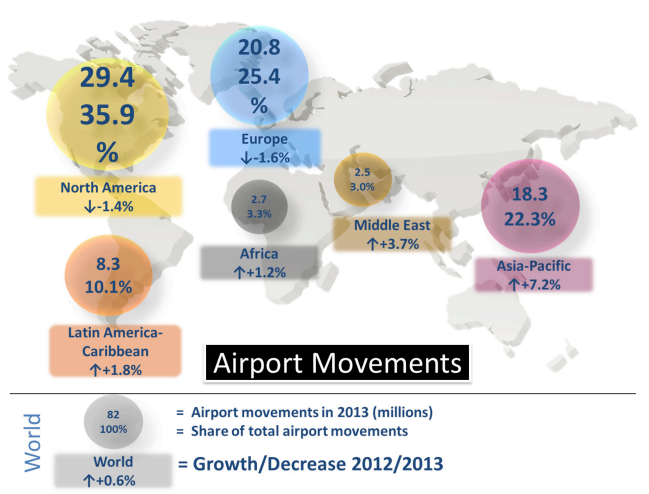CIVIL AIR NAVIGATION SERVICES ORGANIZATION (CANSO)
Aviation is a key sector in the world economy. It both drives and supports global economic growth. On a global level the aviation market was boosted by strong growth in emerging markets, transporting approximately 3.1 billion people and 49.3 million tonnes of cargo according to the International Air Transport Association (IATA) in 2013. Airports Council International (ACI) figures show 4.6% growth in passengers compared with 2.4% growth in global GDP, reflecting the continued economic recovery after the financial and economic crises of 2008-2009. For air navigation services (ANS) the key measures of activity are Instrument Flight Rules (IFR) flights, IFR flight hours and IFR airport movements.
While there is an evident link between the growth in passengers and ANS activity, the impact of passenger growth on ANS demand may be muted by either an increase in the average size of aircraft or load factor, as airlines strive for further improvements in operational efficiency. According to IATA figures this was the case between 2012 and 2013. Load factors rose across all regions with the global average increasing 0.4% to 79.5%. The increase in aircraft size is also indicated by the 4.8% growth in airline capacity (as measured by ASK). This means that while air traffic, measured by number of passengers, grew at close to the historic yearly average of 5%, the demand for ANS services grew markedly slower.
Data from ACI which records information from 1,989 commercial airports in 160 countries saw worldwide aircraft movements increase As the demand for air travel increases, the industry faces a number of challenges including airport and airspace congestion, fuel price volatility and increasing greenhouse gas emissions. For example, high traffic growth can lead to capacity concerns, putting pressure on infrastructure and requiring high rates of investment to keep up with forecast demand. This also extends to ensuring that airport capacity and airspace capacity increases are balanced.
Trends in traffic also provide an important context for analysing ANS performance. Increasing traffic is conducive to improved cost efficiency and an unexpected decrease in traffic will tend to worsen efficiency indicators, especially in the short term where costs are less flexible. 0.6% in 2013 to 82 million, with mixed levels of growth across all six regions. North America and Europe remained the largest traffic areas by movements, though both experienced negative growth in 2013. Asia Pacific showed the highest rate of growth of movements at 7.2%, markedly above that of any other region, boosted by economic growth and increasing domestic air travel. The second fastest growing region was the Middle East (3.7%) where the use of hub airports as focal points between East and West is further developing, following the rise of “South-South” trade links between Africa, the Middle East and Asia.
Download full version (PDF): Global Air Navigation Services Performance Report 2014
About the Civil Air Navigation Services Organization (CANSO)
www.canso.org
CANSO – the Civil Air Navigation Services Organisation – is the global voice of air traffic management (ATM) worldwide. CANSO Members support over 85% of world air traffic. Members share information and develop new policies, with the ultimate aim of improving air navigation services (ANS) on the ground and in the air. CANSO represents its Members’ views to a wide range of aviation stakeholders, including the International Civil Aviation Organization, where it has official Observer status. CANSO has an extensive network of Associate Members drawn from across the aviation industry.
Tags: Air travel, airports, CANSO, Civil Air Navigation Services Organization







 RSS Feed
RSS Feed